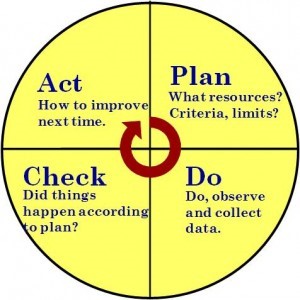The plan do check act (PDCA) cycle, also known as the Deming cycle, is named after Dr. W. Edwards Deming, an influential figure in the field of quality management and process improvement. Dr. Deming was an American statistician, engineer, and management consultant who made significant contributions to the development of quality control and management practices.
The origins of the PDCA can be traced back to the early 20th century when Walter A. Shewhart, a physicist and statistician, introduced the concept of the Shewhart cycle. Shewhart’s cycle consisted of three steps: specification, production, and inspection. It focused on statistical control of processes and was a precursor to the PDCA cycle.Deming improvised on Shewhart’s cycle and re-introduced Deming Wheel in the latter stages of the 20th century (specifically in 1993), and called it the PDSA Cycle
In order to focus more emphasis on the analysis of the actions done and the outcomes attained, he replaced the “Check” stage with the “Study” phase. From there, he evaluated the findings and came up with potential improved methods to achieve the intended outcomes.In this article we will learn more about PDCA cycle, in brief.
The steps involved in Deming PDCA or PDSA (Plan-Do-Study-Act) Cycle as shown are as follows:
- Plan a change (P).
- Do it (D). Carry out the change as suggested either on a small scale or as a prototype.
- Check it (C). Observe the effects of the change. Study it (S).
- Act on what was learnt (A).
- Repeat the same process from Step 1 with new insights and continuously evaluate and improve.
PDCA is not a concept that looks easy to understand but if one is interested in an ISO Management System standard, then it is evident that a PDCA cycle lays down a solid foundation for greater control and is immensely beneficial. Better understanding of a PDCA cycle makes it easier for implementation.

How is PDCA cycle relevant in ISO?
ISO Standards that are developed off late are based on a high-level structure that has ten clauses. These clauses have to be followed by all ISO management system standards and are framed around the PDCA cycle. This is so needed that all standards developed will have the same look and feel and will enable easy integration with the various ISO standards.
As a structured ISO standard, the requirements defined in the form of clauses are as per the PDCA concepts. For an ISO system to work effectively, focus has to be given on each PDCA element equally and it is not limited to a few areas like Plan, Do while neglecting the other two elements (i.e. Check & Act).
In the ISO 9001 standard, the concept of Process approach is detailed on how important it is to implement an International Management System Standard that is compliant with the requirements. The methodology known as “Plan-Do-Check-Act” is being used and applied to all processes across the standard requirements. This helps in showing us on how the standard requirements are aligned within the PDCA cycle.
The goal of any international management system standard developed by ISO is to work towards the improvement of a company. Any organization that thrives in the industry would want to improve their processes internally to be able to compete in the market. With the help of the PDCA cycle, any organization will be to focus on the processes and objectives of the ISO Standard and its overall expected improvement. This subsequently leads to saving valuable time and money that can be used to deliver higher quality products and services. A focus on quality to deliver the end products would largely differentiate an organization with their counterparts. To understand the scope of quality in a better manner and its influence across the organization, please do read our blog on total quality management.
We can now look at each PDCA element and how ISO Standard clauses align with Plan Do Check Act.
PDCA – PLAN
Any business should have a planning cycle that chalks out the plans which includes stakeholders, organization values, objectives, policies, budget, resources and the related documented information.
These are the high-level planning elements.
Maintain QMS (4.1, 4.2 & 4.3)
Leadership (5)
Planning (6.1, 6.2, 6.3)
Manage Resources (7.1)
Document QMS (7.5)
PDCA – DO
This is the actual execution phase of whatever has been planned based on the objectives set by management. This activity/task generates various sets of data and records on a regular basis while the plans are being executed. The data that is generated in tandem with the process of execution are then used for the measurement and analysis. The junk of execution is focused around clause 8 – Product Realization. Most of the documented information is around clause 8.
Competence (7.2)
Design, Develop, Realize (8)
Purchasing (8.4)
Product & Service Provisions (8.5)
PDCA – CHECK
Once we have the data or records generated through “Do” phase, this must be analyzed or studied (Deming’s PDSA cycle – Study).
As discussed before, the focus of Deming was to give impetus on analysis and study of the data generated from ‘Do’ phase rather than just to check if the execution was a success or failure of what was planned.
Alignment of ISO standard with PDCA cycle defines a way to check processes internally in order to identify how well an organization has been executing the plans as defined.
Monitor & Measuring (9.1)
Customer Satisfaction (9.1.2)
Data Analysis (9.1.3)
Internal Auditing (9.2)
Management Reviews (9.3)
The processes that are defined in the form of ISO standard is not a one-time activity, but they have to be performed on a repeated basis and on a regular interval until the desired results are achieved.
PDCA – ACT
This phase is all about the actions taken to close the issues/gaps that are identified during the ‘Check’ phase. It is during the ‘Check’ phase that the actual measurement and analysis of deviation from plan versus the records are evident during execution. It is also imperative for the management to take steps as part of ‘Act’ in areas like management review. This step involves action plans set by management to either act as a corrective measure to overcome the failures in the process or as a step taken to prevent further deviations.
Risk Management (6.3)
Nonconforming Product (8.7)
Corrective Action (10.2)
The same Plan Do Check Act cycle will be used in various phases of standards like training, documentation, support activities etc. The whole concept of continuous improvement relies on the PDCA cycle and the ease of implementation of ISO standards largely depends on how effectively the PDCA cycle played its role in aligning the business objectives and processes to the ISO standard requirements.
AI SECURITY: UNDERSTANDING THREATS AND COMPLIANCE SOLUTIONS
Artificial Intelligence continues to grow and become more relevant in workplaces. Customers widely use it to handle market products. Organizations are desperately using AI for their businesses, ensuring that the AI systems comply with the new rules and regulations. In...
HOW DOES THE NIST CYBERSECURITY FRAMEWORK FUNCTION, AND WHY IS IT IMPORTANT?
Emerging cyber threats make cybersecurity an essential consideration for organizations handling and managing data. In this regard, the NIST cybersecurity framework applies to improving your cybersecurity program. It is a set of guidelines that helps improve your...
UNDERSTANDING ISO 42001: A GUIDE FOR RESPONSIBLE AI MANAGEMENT SYSTEMS
The invention of artificial intelligence (AI) has changed the operational processes of many industries. However, the rapid growth of technology increases ethical, security, and privacy-related concerns. Therefore, the International Organization for Standardization...




